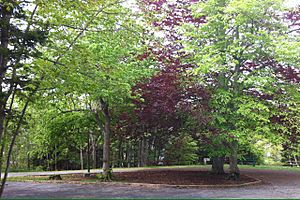St. Aspinquid's Chapel facts for kids
St. Aspinquid's Chapel was a special place created by a priest named Louis-Pierre Thury in the late 1600s. It was built in an area called Chebucto, which is now Halifax, Nova Scotia. This chapel is a natural stone area that looks like an outdoor theater. It's found near Chain Rock Battery in Point Pleasant Park, right by the Northwest Arm.
Many important people are buried in the ground around the chapel. It was also a significant spot for the Mi'kmaq people. They held a special celebration there called the Feast of St. Aspinquid for most of the 1700s. During the French and Indian War, two Mi'kmaw chiefs even had a conflict near the chapel in 1760.
Contents
Who Was St. Aspinquid?
People say that Father Thury named the chapel after a Mi’kmaq leader named Aspinquid (sometimes spelled Aspenquid). This chief became a Catholic and inspired many others to join the faith. Father Thury arrived in Acadia in 1684. He traveled with St. Aspinquid all over the region, including what is now Nova Scotia.
Chief Aspinquid was known as the "Chief Sacham of all the Tribes of Indians in the Northern District of North America." This means he was a very important leader for many Indigenous groups. During a conflict called King William's War, he was also a political figure. He signed a peace agreement with Massachusetts Governor William Phips on August 11, 1693.
Sadly, Chief Aspinquid was killed in February 1696. A few months later, Father Thury, along with Mi'kmaq and other Indigenous fighters, got revenge during the Siege of Pemaquid (1696). Because of his death, Aspinquid was seen as a hero and became known as a saint. He is buried at Mount Agamenticus in what is now Maine.
After St. Aspinquid's death, Father Louis-Pierre Thury became the main missionary for the Mi'kmaq people. He worked in areas like Shubenacadie and Chibouctou (Halifax) starting in 1698. Thury was the first missionary sent to the Halifax area.
The Feast of St. Aspinquid
It is believed that Father Thury combined the Christian holiday of Easter with an ancient Mi'kmaq spring festival. He then renamed this combined celebration the Feast of St. Aspinquid. Historically, this feast was the biggest social event of the year for the Mi’kmaq community. Many different Indigenous groups from across the northeast region would come together for it.
The festival was usually held in May, right after the first quarter of the moon. During a conflict known as Father Le Loutre's War, the feast stopped for a while. It started again after the Burying of the Hatchet Ceremony in 1761. Oral stories say that Michael Francklin encouraged the Mi’kmaq to continue their tradition at St. Aspinquid's Chapel.
However, in 1786, local leaders became worried about the Mi’kmaq supporting American patriots during the American Revolution. Because of this, further celebrations of the old feast were not allowed.
A Conflict at St. Aspinquid's Chapel
Stories tell of a conflict that happened at St. Aspinquid's Chapel in Point Pleasant Park, Halifax. Lahave Chief Paul Laurent and eleven of his people invited Shubenacadie Chief Jean-Baptiste Cope and five others to the chapel. They wanted to talk about making peace with the British. Chief Paul Laurent had just come to Halifax after giving up to the British at Fort Cumberland in February 1760.
In early March 1760, the two groups met. Instead of peace talks, they ended up fighting. Chief Laurent's group killed Chief Cope and two others. In return, Chief Cope's group killed five of the British supporters.
Soon after Cope's death, Mi'kmaq chiefs signed a peace treaty in Halifax on March 10, 1760. Chief Laurent signed for the Lahave tribe. A new chief, Claude Rene, signed for the Shubenacadie tribe.
Burial Ground
The burial ground at St. Aspinquid's Chapel holds the remains of several important people. Father Thury was buried there on June 3, 1699. This was the first recorded burial in Halifax. Shubenacadie Chief Jean Baptiste Cope (1760) and Halifax Chief Paul, the last Mi’kmaq chief of the Chebucto tribe, are also buried there.
In 1746, a French fleet known as the Duc d'Anville expedition arrived. Many of the crew were dying from a sickness called typhus. This disease spread to the Mi’kmaq people who were in Chebucto, and many of them died. A large number of these Mi'kmaq people are buried in this burial ground.
Images for kids



